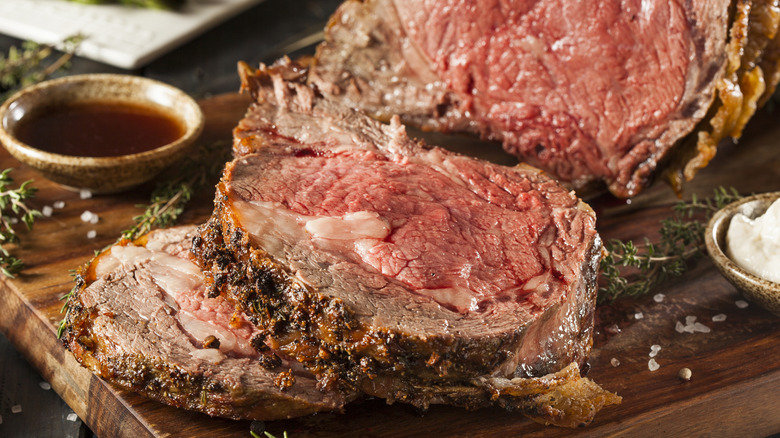Rib Roast Vs Prime Rib: What's The Actual Difference?
We may receive a commission on purchases made from links.
One would think that prime rib would be a superior cut of meat compared to a rib roast, with "prime" being right in the name. However, that isn't necessarily the case. According to Meathead — a BBQ Hall of Famer, the founder of AmazingRibs.com, and author of the best-selling "Meathead: The Science of Great Barbecue and Grilling" and the newly-released "The Meathead Method" – prime rib gets its reputation as a first-rate cut because folks aren't generally familiar with how it got its name.
"Prime rib and rib roasts are the same exact thing," Meathead said. "Prime rib's name is confusing because it is not necessarily USDA Prime. It gets its name because it is from the rib primal." In other words, prime rib is named after the part of the cow it comes from — it doesn't have anything to do with quality. While it can be USDA Prime, it can also be Choice, which has less extensive marbling. Surely, that's something to consider when you are buying prime rib at the grocery store.
Whatever you choose to call it, this cut typically comes with a hefty price tag. You could purchase an alternative to prime rib if that is still too pricey. However, if you want to experience the tender, juicy texture that a prime rib/rib roast provides, you will have to spend a little extra dough.
Tips for cooking prime rib and rib roast
On AmazingRibs.com, Meathead shares tips and tricks for preparing rib roast. One crucial mistake would be overcooking the protein, so he recommends keeping it to a top temp of 130 to 135 degrees Fahrenheit and looking for a deep red interior. Because a rib roast typically has the bones removed before it sells, it tends to be more expensive than prime rib. However, if you opt to get a deal by purchasing the meat with bones attached, Meathead urges that you remove them before roasting, as they can impede the formation of a delicious crust when left on. A gorgeous crust, or bark, that's been seasoned to perfection is essential for a good rib roast, and you want as much of that as possible so everyone around the dinner table gets a bite.
Contrary to what some suggest, the fat cap that crowns the protein should also be removed before cooking. Meathead notes that it's intramuscular fat that lends flavor, not the stuff on top (which just isn't going to penetrate the muscle beneath). Removing the fat cap also allows you to get more seasoning on the surface of your mouthwatering roast.
One less common technique Meathead has utilized for a juicy prime rib is sous vide. Using an immersion circulator, cook the meat with even heat in vacuum-sealed bags. When you reach your desired temperature, cut the meat out of the bag, season it, and get a grill piping hot. Give every side of the rib roast an even, crusty sear, then enjoy your juicy protein.

